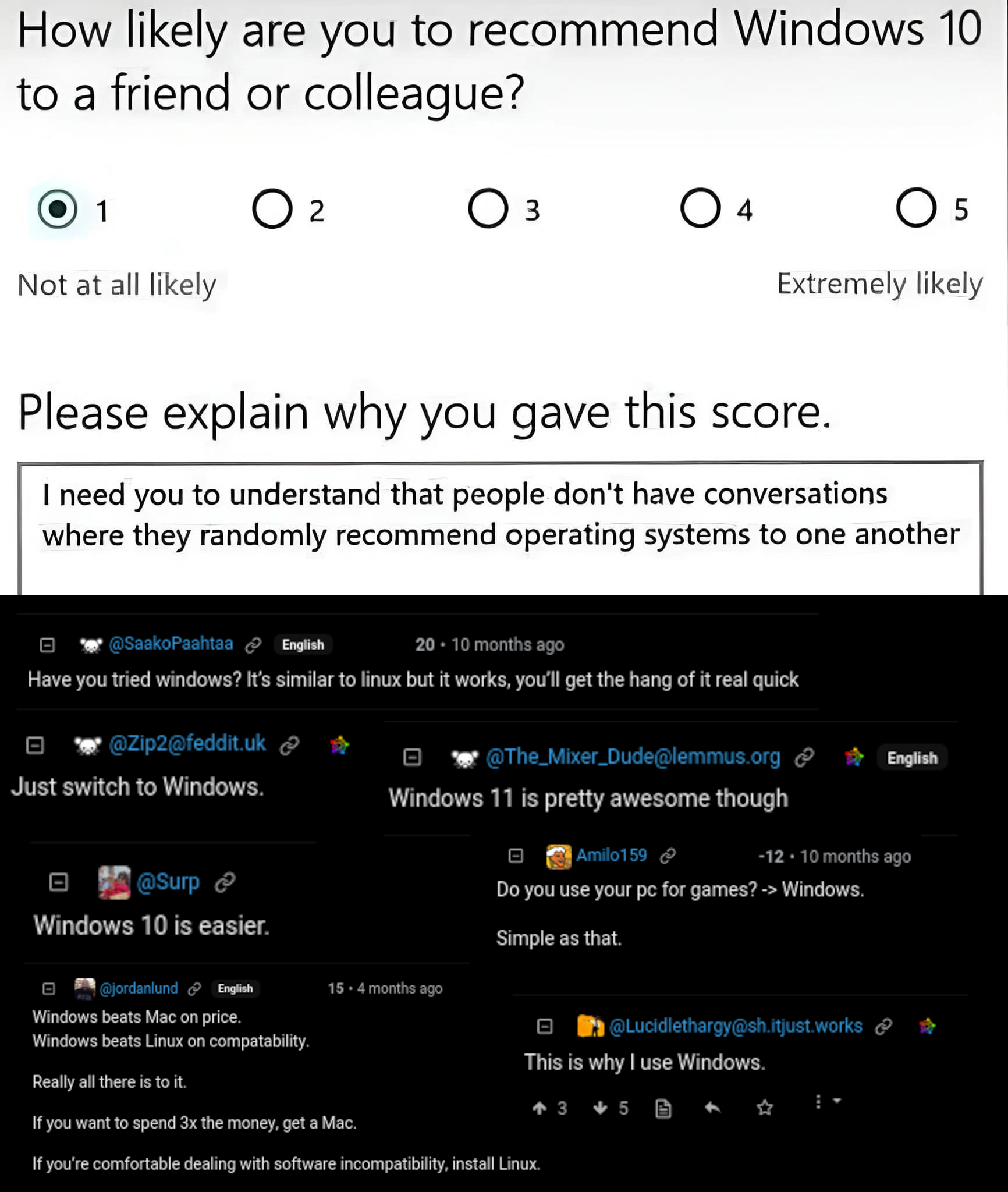" i shouldn’t have to memorize commands"
the up arrow:
The commands: ls cp mv…
Meanwhile you get Windows people who memorize things like Get-AllUsersHereNowExtraLongJohn
Get-ListOfFunnyPowershellReferences++
(Seriously…
ExtraLongJohnis damn funny)Get-command -noun <string[]>
Handy AF
In PowerShell most common cmdlets for basic operations have aliases by default. And funnily enough you can use both Windows (
cmd.exe) and Unix shell names for these. (copyvscp,delvsrm, etc.)AFAIK The cmdlets that you use only by Verb-Noun convention are mostly used in scripts, or in some administration tasks.
I also think that some poeple miss the point of PowerShell, as it’s not supposed to be worked with like with Unix shells, since it’s more object-oriented than string-oriented.
Long long maaaaan
Just wait until they learn about ctrl-R haha
I’ve seen people not realize tab autocompletes.
I learned that tab=autocomplete when I first played minecraft in grade school haha. I just assumed that it was common knowledge but apparently not…
Oof, my back.
I’ll save you a spot at the bingo table
This is me. I’m taking the L on this one and I’ve (at least occassionally) used Unix-like systems professionally for 15 years. I’m all self-taught on Linux and didn’t figure out Tab until I was doing some awful Grub troubleshooting and it spells out that tab autocompletes. So I tried it in terminal and then smirked at the camera like Jim
These people would be mind-blowing if they try fish.
Holy shit
Wait until you learn about fzf - a replacement for ctrl-r that offers fuzzy search with a nice tui
I’m completely familiar with fzf!
I also generally tap in the first few letters of a command then use pgUp (on my system) to autocomplete. Or use the ol’ !<command#>.
But I have somehow never friggin heard about Ctrl+r.
Huh, interesting, I never used fzf outside of ctrl-r!
holy hell
old response dropped
actual Redditors
I’m the type to spend 10 minutes going through my previous commands, rather than 5 seconds typing it.
I’ve got
haliased tohistory | grepand it’s been revolutionaryAlternatively, ctrl+r
Sounds like you should try fzf to get a better ctrl+r experience.
Up arrow about 400 times for that one command*
See also: atuin - a shell history tool that records your shell history to sqlite.
Seamless sync across shell sessions & machines, E2EE + trivially self-hostable sync server, compatible with all major shells, interactive search, etc.
GNU Terry Pratchett
“Alias? What is that?”
That’s it, I need to hook up a controller to my PC so I can open Htop with a button press
Almost as painful as using vim on your phone without an external keyboard
I genuinely use vim inside of termux on a daily basis. I dunno if I’m sick in the head or what, but I kinda like vim on my phone.
Yeah I was gonna say that while it sounds completely unusable, it’s surprisingly not too bad actually. Some of the more complex shortcuts can get pretty tedious, but nothing that a good config can’t solve.
I remember once my friend’s laptop died, and while it was in RMA he was using his phone with an external keyboard and mouse to develop a webapp lol. Just goes to show that any computing device that can run a web browser and VIM covers 90% of your daily software needs haha.
Just use a MIDI controller or an Arduino button box. You can do it!
What are you, a Tintin villain based on Greek stereotypes?
Personally I just run gotop at startup and keep it on my second monitor. I know it’s a small waste of resources but I enjoy watching the blinkenlights.
If you’re on Xorg, you can also use xwinwrap to make gotop (or any other app) your wallpaper btw. Kinda useless on a tiling WM tho
Make all your windows translucent!
btop could be pretty controller friendly
I love btop!
The only thing worse than reading documentation/tutorials about how to do things in GUIs is writing documentation about how to do things in GUIs. It’s just screenshot after screenshot. And following it is like playing a ScummVM game, only less fun and lots more alt+tabbing.
Screenshots? Look at Mr. Speedy Pants over here!
In my experience, half the time it’s a bloody YouTube video. Nothing says “fun” like having to seek back around in a video to find the next step without waiting 20 extra seconds because you already had to seek back and pause the video after it breezed past an overcomplicated and poorly explained step.
Unregistered hypercam 2 + notepad instructions + evanescence is an aesthetic tho
And the audio is text to speech because it was created by some 12-year-old neckbeard (is that a contradiction?) who is too embarrassed to use their voice on the video they made just to get likes and subscribers.
My experience has usually been someone with a very thick accent and an incredibly crappy microphone.
If the GUI is good, then it’s self documenting.
I’ve got a new favorite quote: “I don’t need tutorials, I need verbose tooltips.” -Wonderbot
Are there people who are mad at other people for using the terminal? Is this really a thing that exists?
Usually it’s the other way around
Not really. But you know, gotta find ways to feel smarter than other people so here we go.
And those Windows evangelists! Don’t we all know 'em with their strong opinions about operating systems? *shakes fist at cloud*
Yeah you just can’t be in a server room anymore without some dude trying to sell you on Office365 and Cortana, sigh.
Do you have a moment to talk about our Lord and savior, the Microsoft App Store, and his enlightened prophet, Candy Crush Saga?
It’s not that they are mad others use CLI, it’s that they’re mad that Linux devs regularly stop creating P&CI features, instead opting for CLI with no P&CI equivalent action.
It’s kind of obvious why - CLI is already very flexible right out of the box, and it takes much less work to add functionality within CLI rather than creating it for the P&CI.
At the same time, I understand the P&CI folk’s frustration, since one of biggest obstacles to getting more people on Linux is the lack of P&CI solutions, and the fact that many actions on Linux are explained solely via CLI.
CLI folks have invested the time to use terminals effectively and view overuse of the P&CI as beneath them, and P&CI folks have no interest in dumping time into learning CLI to do something they could do on Windows with P&CI.
Pardon my ignorance but what does P&CI stand for?
Edit: nvm got it I think it’s Point & Click Interface
Correct, point and click interface
Linux is the terminal.
The GUI applications are just terminal applications where you press buttons instead of typing. Creating the buttons and UI is extra overhead for developers.
CLI folks have invested the time to use terminals effectively and view overuse of the P&CI as beneath them, and P&CI folks have no interest in dumping time into learning CLI to do something they could do on Windows with P&CI.
There are people who have learned to use Linux, using whatever tools are best for the job and people who have decided that the only way to interact with a computer is with a mouse and refuse to learn anything else.
You don’t have to swap away from Windows. But, if you choose to, know that you will have to learn a new operating system and, on Linux, this means becoming familiar with the terminal.
If you’re going to artificially limit yourself, despite the chorus of Linux users telling you otherwise, by deciding that any terminal use indicates a failure of the OS or of developers, then you should not use Linux.
It’s hard enough to learn a new OS. Artificially restricting yourself to only using your mouse is going to severely limit your ability to function.
Obviously I’m talking about the DE packages, not the kernel or CLI base. We are talking about windows users switching to linux-based DEs, which are directly trying to compete with Windows and iOS.
This is not me having issue with CLIs. I’ve been on Linux for decades. I am pointing out the perspective of those that are frustrated with Linux DEs being blatantly unready for mass-adoption, specifically because they expect layman users to learn CLI. See my previous comment and this comment for more details.
I do understand their perspective.
It’s just that their expectations do not align with reality and they’re only going to hurt their experience by thinking that there is a path to using Linux without using the terminal. Some distros do a really good job of creating something that seems like a pure GUI experience, but that illusion only lasts right up until there is a problem that the UI designers didn’t anticipate and the only way forward is to type terminal commands.
I’m not trying to be an asshole when I say this kind of thing.
It’s just disingenuous for people to recommend Linux and also say ‘Don’t worry, you won’t need the terminal’ or to foster the illusion, in new users, that their fear of the terminal is justified. I get that, of all things Linux, the most alien thing from a Windows/Smartphone user’s perspective, is a text-based interface.
It seems difficult and social media is full of people acting like the terminal is incredibly difficult to learn so people believe that they can simply opt out of using the terminal. You can’t, and trying to do so is going to make users have a horrible experience. It’d be like telling people that Windows doesn’t require a mouse, that’s possibly true but if a person artificially limits themselves in that way, they’re going to have a much harder time than they would have if they’d spend the time to use the OS properly.
This is kind of erasing the author with your description of the issue. The reason that apps eventually require CLI to complete tasks is because devs think of CLI first and then produce a stop-gap P&CI over top of it. It is explicitly how devs in the Linux environment operate which creates a gap between CLI and P&CI. If apps were developed with P&CI in mind first, with CLI added after, this would not be a problem - and we know this because of every app developed for both Windows and Linux, which lack these gaps in functionality - or lack CLI entirely.
Your stance also de-emphasizes the difficulty of learning CLI for the first time. It’s not the most difficult thing ever, but it can be fairly frustrating. It’s not something you want to deal with when just trying to unwind after work on your PC, or while you’re trying to do your job at work. I think it’s pretty reasonable most people don’t want to have to learn yet another paradigm just to do what they’ve already figured out how to with a P&CI.
Being realistic, of course, this paradigm shift is not going to happen. Linux will continue to be only a small portion of total computers used by end users because of this, and various other reasons it’s found unpalatable.
I’ve heard that KDE and GNOME, however, are both at a level now where P&CIs are all you really need. I have not tried them myself, though.
The CLI is first because Linux is, first and foremost, an operating system built for terminal access. It was based on Unix, a mainframe operating system that served terminals.
I’ve heard that KDE and GNOME, however, are both at a level now where P&CIs are all you really need. I have not tried them myself, though.
Between all of my devices at home and work, I use KDE, XFCE and hyprland.
KDE has a pretty comprehensive GUI, but to say that they’re all you need is a gross exaggeration. Sure, you can connect your bluetooth device via the GUI but if there is any problem with it the GUI is woefully insufficient for troubleshooting. Similarly, you can adjust the volume in the GUI… but if your device is using the wrong bitrate or you want to do anything more complicated than control the device that sound is sent to, then you’re going to be editing dot files and using the terminal.
In Linux, the GUI applications are a convenience but the core of the system is the terminal interface. That’s what everything has been designed for since the beginning. Graphical Desktop environments are not, at all, a replacement for the terminal.
Your stance also de-emphasizes the difficulty of learning CLI for the first time. It’s not the most difficult thing ever, but it can be fairly frustrating. It’s not something you want to deal with when just trying to unwind after work on your PC, or while you’re trying to do your job at work. I think it’s pretty reasonable most people don’t want to have to learn yet another paradigm just to do what they’ve already figured out how to with a P&CI.
I don’t think that it is reasonable to want to swap operating systems without learning the new operating system.
If a person has decided that they never want to use anything but a mouse to solve their problems then Linux is not the OS for them. Learning a new operating system means learning how the operating system works, not declaring how you think it should work and declaring anything outside of your expectations as unreasonable.
If you’re coming into this with the idea that you’re going to swap to Linux but only use your Windows/Mac knowledge to puzzle through a GUI and also refuse to touch anything that is in the terminal then you should not use Linux. If you’re asking for help and then telling the people trying to help you that you’re not going to use the terminal, you’re going to face a lot of negative responses.
they’re mad that Linux devs regularly stop creating P&CI features, instead opting for CLI with no P&CI equivalent action.
I’ve never seen this?
It’s typically a completely different developer who creates the CLI first, and then one of us adds a P&C after.
So if something is brand new, sure there might be no P&C, yet.
I promise There’s no conspiracy to not have nice things. Haha.
I was specifically trying to not sound conspiratorial. I’m pointing out that it’s a matter of having learned a paradigm vs having to learn a new paradigm.
Devs have already gotten used to CLI and very rarely make full P&CI suites because of it. Even if the original Dev only did CLI for the app and someone came back and made a P&CI for that app, those P&CI interfaces are still fairly barebones. This is both a mix of devs knowing how good CLI can be and because it’s all open source volunteer work.
Layman users of P&CI-focused DEs actively avoid CLI so they don’t have to learn it. This means that using most Linux apps are something to be avoided for most Windows users, making the OS base mostly unusable for them.
To be clear, when I am talking about P&CI-focused DEs, like windows and iOS, I mean that if you cannot perform an action with the P&CI, then that action essentially does not exist for the average user. Contrast that with Linux DEs, where it’s quite common to have to directly edit configs or use the CLI to perform various actions.
As a veteran user, CLI does not bother me. I do understand the frustration of those who want some Linux DEs to become as default as Windows and iOS, because lack of P&CI does damage that effort.
This is not every app in Linux obvi, but the ones that are best at making sure the P&CI is full-flddged, are the apps that develop for windows and iOS as well as Linux - Blender, LibreOffice, Logseq, Godot, etc. The most common offenders are the utility apps, such as those that handle drivers, sound systems, DE functions, etc.
This means that using most Linux apps are something to be avoided for most Windows users, making the OS base mostly unusable for them.
I take your point. And this was very much the case for a long time.
But it’s worth pointing out that Gnome and KDE are both done, now.
I haven’t been forced to reach for command line to change something - anything - on either of my last couple of Linux installs.
Edit: I almost didn’t notice, but it feels worth celebrating and raising awareness.
I don’t think so, but I do criticize not having an option, that is why I stopped using Cisco personally and professionally, some things are fast using the cli, some things just need an Ui, you need both.
A cli is a ui. I know that’s pedantic but this is Linux memes
another name for CLI is the TUI (Terminal User Interface)
See, in my mind, a CLI is a line buffer-based interface, whereas a TUI is an interactive character-based interface.
sedorbashis CLI andviorrogueis TUI.You make a fair point
I think of tui as “text user interface” and use it as a broad category but mostly for more advanced clis that have a graphical quality to them despite being text based, such as ranger or slack-term. Some tuis even have mouse controls!
Like I get and appreciate the CLI and for networking, that’s pretty much all I’m using anyway, but I am shocked that enterprise networking doesn’t even bother to do any GUI. Once upon a time Mellanox Onyx bothered to do a GUI and I could see some people light up, finally an enterprise switch that would let them do some stuff from a GUI. Then nVidia bought them and Cumulus and ditched their GUI.
There’s this kind of weird “turn in your geek card” culture about rejecting GUIs, but there’s a good amount of the market that want at least the option, even if they frankly are a bit ashamed to admit it. You definitely have to move beyond GUI if you want your tasks to scale, but not every engagement witih the technology needs to scale.
In a pretty high end high tech company, there’s still lots of people who see a terminal and think “ha hah, they are still stuck in old mainframe stuff like you used to see in the movies”.
My team determined long ago that we have to have two user experiences for our team to be taken seriously.
A GUI to mostly convince our own managers that it’s serious stuff. Also to convince clients who have execs make the purchasing decisions without consulting the people that will actually use it.
An API, mostly to appease people who say they want API, occasionally used.
A CLI to wrap that API, which is what 99% of the customers use 95% of the time (this target demographic is niche.
Admittedly, there’s a couple of GUI elements we created that are handy compared to what we can do from CLI, from visualizations to a quicker UI to iterate on some domain specific data. But most of the “get stuff done” is just so much more straightforward to do in CLI.
To me apt is confusing but that’s because I’ve become so used to pacman. The only package manager that comes close to pacman for me is xbps.
Yeah apt tends to shit itself very often. I don’t like how it’s actually two different programs (dpkg and apt) glued together with perl and python. It all feels too fragile. A friend once tried updating a package, and it failed because… he was issuing the apt command from with a python virtual environment. Can’t say for pacman because I’ve never used arch, but xbps is just one set of self-contained binaries, which feels much more robust. Alpine’s APK fits that bill as well, lovely little package manager. Tho I guess apt predates both of those, so it’s not a fair comparison. Someone had to make those mistakes for the first time.
I also really dislike the Debian/Ubuntu culture of fucking around with the sources file to add other people’s repositories on top of the distro-default ones (ubuntu calls this PPA). It’s a good idea in theory, but in practice those third party repos always fuck up in some way and brick your package manager. Just search for “apt Failed to fetch” in your favourite internet search engine, and you will see hundreds of people confused about it. You can do it with almost any package manager, but for some reason it’s mainly the debian/ubuntu people who like shooting themselves in the foot like this.
Yes, that’s a real thing. They use it as an excuse to dog on linux distros & say “Muh linux not great yet”
Maybe I misinterpreted the meme, I thought the yelling guy is also a Linux user.
I have a coworker that likes to pick fun at my usage of CLI tools. He said it’s confusing “why would I use a terminal when the GUI was made after?”. They vehemently hate anytime they have to work with CLI.
I watched them use an FTP program to download and change one value in a .conf file. Like they downloaded the file, opened it in notepad++, changed one thing, saved it, reuploaded / overretten the original. I tried to show them how to just use nano and got told their way was “better since you could ensure the file was replaced”. Its okay, I’ve secretly caught them using it a couple times lol
Fortunately, Linux terminals are gorgeous and easy to use. I never wanted to use Windows’ com because it was so ugly and user-hostile. I know Powershell is a thing now, but it still looks ugly to me.
Speaking from experience… Yes. Absolutely yes.
meanwhile Windows users: let me drop into this random strangers discord who claims he will make my PC faster by dropping this .bat file that will run thousands of commands to “debloat” my install. also let me edit the registry and add random values to keys that I don’t know what they’re used for. this process is basically irreversible because I will inevitably forget which keys I’ve edited over time, wow windows is so simple and easy and intuitive 🤡
That’s not a windows problem, it’s a user problem. The same scenario could play out with a shell script that modifies a hundred dotfiles. Lots of solutions on Linux help forums are “Paste this into your terminal. Don’t forget the sudo!”
Amen. I remember having to frequently reinstall the system to keep it performant. Thanks windows rot.
I actually used to make backups (Export) of each edited key and keep them in folders with context, so I could later look them up or even set them again in case of a reinstall.
Now, they are lying, forgotten, on some NTFS drive that I haven’t opened in years.
deleted by creator
Setting the colorscheme to green on black increases hacker rating by 20%
I would recommend Cool retro term for that, but you need to run it on a CRT to make it full.
courier gets you another 15%Change font into hack gives another 20%
cmatrix -rf
I use Linux and I prefer GUIs. I’m the kind of person that would rather open a filemanager as superuser and drag and drop system files than type commands and addresses. I hope you hax0rs won’t forget that we mere mortals exist too and you’ll make GUIs for us 🙏🙏🙏
Tbf, the file explorer is actually one really good argument for GUIs over terminals. Same with editing text. Its either simple enough to use Nano or I need a proper text editor. I don’t mess around with vim or anything like that that.
Its all tools. Some things are easier in a file manager, some things are easier in a GUI.
You’ve angered the Emacs gods 😨
Good. They need to be humbled haha
I think it depends, if I have a simple file structure and know where stuff is, it’s pretty efficient to do operations in the terminal.
If I have a billion files to go through a file manager might be easier.
Nano, the best text editor
Yeah I prefer fancy text editor too. And my biggest heartbreak was learning that I can’t just
sudo kate(there’s a way to use Kate to edit with higher privileges but I never remember how, edit: apparently it’s opensuse specific problem).Born to Kate, forced to nano
The problem is running GUI code as root as it’s never been vetted for that. What you want, effectively, is to have
EDITORvariable of your session set tokateand open system files usingsudoedit. I’m a terminal guy myself, so this exact thing is enough for me. Having said that - I’m sure someone will chime in with a plugin/addon/extension/etc that adds this to the right click context for what I assume is KDE. Or you can try looking for that om your favourite search engine.
I use both, depends a bit on the task at hand. Generally simple tasks GUI and complex ones CLI. Especially if I want anything automated.
I tried to learn superfile thinking it could make terminal more exciting but nah.
Gimme that comfy file explorer gui.
Totally agree.
It depends. But yeah I’d rather use something like Handbrake than raw dog FFmpeg.
FWIW I do use the file browser too when I’m looking for a file with a useful preview, e.g. images.
When I do have to handle a large amount of files though (e.g. more than a dozen) and so something “to them”, rather than just move them around, then the CLI becomes very powerful.
It’s not because one uses the CLI that one never used a file browser.
Yeah, when I need to inspect lots of images I just open the folder in gwenview.
For peeking at a single picture or two through you can hold down control and click/hover on the filename when using Konsole. Love that feature. You can even listen to
.wavfiles this way.Very nice, I don’t seem to have that option available but I can right-click on a filename to open the file manager in the current directory. Good to know!
I once did
rm \*accidentally lol. I now have a program that just moves files to trash aliased as “rm” just in case. I just don’t feel confident moving files in CLIYeah it happened to all of us. The console is powerful and it means when you mess up, it will have BIG consequences. One learns to test first before globbing https://en.wikipedia.org/wiki/Glob_(programming) too much!
I would say “why not, to each their own” if not the thought about what else the filemanager is going to do with root access (like downloading data from web for file preview). But the general sentiment still stands, it is absurd to think that computer must be used only in one way by all people
I mean, the reverse is also true, people have memorized which buttons, menus, etc they need to click/drag with do be productive. Sometimes i m OK with all the clicking, but most times I just want to do the thing now.
Type 3 words or click through 9 context menus. 😅
Yeah exactly ANY interface made by humans speaks a design language, and it’s only “intuitive” insofar as the user understands that language. There’s nothing inherently “intuitive” about GUI, it’s a language that you’ve learned through a long process of trial and error. This is painfully obvious to anyone who’s ever had to help Grandma reset her gmail password out over the phone. Same for CLI. At first you’re copy-pasting commands from tutorials and struggling with man pages, but after a while you get used to the conventions. You learn that
-hhelps you out and--verbosetells you more and so forth. You could make the case that the GUI design language is more intuitive because it’s based of physical objects like buttons and sliders that many people are familiar with, but honestly ever since we abandoned skeumorphic design that argument rings a little hollow.That’s a very nuanced analysis. I’ve explained it this way especially to people who describe themselves as “bad at computers”. Hey, give yourself a break, you’ve learned a lot about how to cope with windows. But this investment leads to a conservatism— they dont want to learn coping skills o a new system. The devil you know.
I’d just add that GUI is more discoverable. When faced with a terminal, what to do? Whereas with a GUI you have a menubar, some icons etc. The GUI gives a lot more hints.
In the terminal (which I love) it is more powerful once you know how to crack the lid.
Exactly. You need documentation to figure out how to do anything in a CLI, and if you forget it’s back to the documentation, but a GUI exposes all its commands immediately, allowing the user to find things on their own.
Except the iOS UI, which is heavily reliant on gestures with varying numbers of fingers, pressure dependent touch commands that are difficult to pull off consistently (seriously, how the hell do you deliberately do the multi-select drag thing?), and hidden menus that are exposed by dragging in from specific portions of the screen at specific angles with no hint that they’re there.
This is an incredibly sane dissection, wasn’t expecting it under a meme
CLI is effective because every command serves a specific purpose. UIs are the opposite, you have to imagine all possible intentions the user could have at any given point and then indicate possible actions, intuitively block impossible actions, and recover from pretty much any error.
CLI is effective also because of its history (i.e. one can go back, repeat a command as-is or edit it then repeat) but also the composability of its components. If one made a useful command before, it can be combined with another useful command.
Rinse & repeat and it makes for a very powerful tool.
The Unix principle of piping between two or even multiple programs, together with “all data should be in the simplest common format possible” (that is, largely unformatted strings), was a really clever invention to be popularized. As proven by the fact it is still so useful decades later on a myriad of computers unimaginably more powerful than what they had back then.
It’s not perfect by any means (alternative title: why something like Nushell exists), but it’s pretty good all things considered I dare say.
Absolutely. I learned about that decades ago as a teenager and never would I have thought it would still be useful today… yet, in 2025 if you want to do anything powerful, in the cloud, on your phone, even in your XR headset, it is STILL relevant!
PS: I project I’m contributing to on the topic https://nlnet.nl/project/xrsh/ ideas welcomed!
Are the “Windows evangelists” in the room with us right now? Every Windows admin I know hates Microsoft with a burning rage. Literally the only people I’ve ever seen promote Windows are being paid to do it.
Counterintuitively, that’s one reason I like dealing with Windows: the community knows what it is and doesn’t pretend otherwise, like some other more “zealous” fan bases.
Literally the only people I’ve ever seen promote Windows are being paid to do it.
Yeah, that’s the demographic I had in mind. Lemmy is full of paid shills lol.

it’s Linux, who’s going to pay them Canonical? IBM? Wait, nvm, I could see IBM having paid shills
Do they have any money?
Having started out in programming before the GUI era, typing commands just feels good to me. But tbh Linux commands really are ridiculously cryptic - and needlessly so. In the 1980s and 90s there was a great OS called VMS whose commands and options were all English words (I don’t know if it was localized). It was amazingly intuitive. For example, to print 3 copies of a file in landscape orientation the command would be PRINT /COPIES=3 /ORIENTATION=LANDSCAPE. And you could abbreviate anything any way you wanted as long as it was still unambiguous. So PRI /COP=3 /OR=LAND would work, and if you really hated typing you could probably get away with PR /C=3 /O=L. And it wasn’t even case-sensitive, I’m just using uppercase for illustration.
The point is, there’s no reason to make everybody remember some programmer’s individual decision about how to abbreviate something - “chmod o+rwx” could have been “setmode /other=read,write,execute” or something equally easy for newbies. The original developers of Unix and its descendants just thought the way they thought. Terseness was partly just computer culture of that era. Since computers were small with tight resources, filenames on many systems were limited to 8 characters with 3-char extension. This was still true even for DOS. Variables in older languages were often single characters or a letter + digit. As late as 1991 I remember having to debug an ancient accounting program whose variables were all like A1, A2, B5… with no comments. It was a freaking nightmare.
Anyway, I’m just saying the crypticness is largely cultural and unnecessary. If there is some kind of CLI “skin” that lets you interact with Linux at the command line using normal words, I’d love to know about it.
Anyway, I’m just saying the crypticness is largely cultural and unnecessary. If there is some kind of CLI “skin” that lets you interact with Linux at the command line using normal words, I’d love to know about it.
This is far more manual than you probably had in mind, but Linux has support for a command called alias, which allows you to basically rename anything you like:
Alias lets you rename commands but not options. For example you could alias “grep” as “search”, but you couldn’t alias the “-h” option as “-nonames” and type “search -nonames” . You still have to type “search -h”.
That’s fair. But it’s at least something.
typing commands just feels good to me
That’s because for the most part, it’s faster. You don’t have to lift one hand off the keyboard. Also using the cursor and clicking on something requires more precision and effort to get right compared to typing a word or 2 and hitting enter.
This is me kinda bragging, but at my typing speeds, something like
ls -lais under half a second. Typing cd proj (tab to auto complete) (first few letters of project name if it’s fairly unique) (tab to auto complete), hitting enter, and then typing a quickdocker compose upis an order of magnitude faster than starting the containers in docker GUI.But tbh Linux commands really are ridiculously cryptic - and needlessly so.
Agreed. Okay, to be fair, for parameters, most of the time you have the double-dash options which spell out what they do, and for advanced users there’s the shorthands so everyone should be happy. But the program/command names themselves. Ugh. Why can’t we standardize aliases for copy, move, remove/delete? Keep the old binaries names, but make it so that guides for new users could use actual English aliases so people would learn quicker?
At least part of this is the decentralized/complied nature of a FOSS operating system. You don’t get a command called grep because someone making design decisions about a complete system holistically decides that tool should be called grep. You get it because some random programmer in the world needed a way to find patterns in text so they wrote one and that guy called it grep and someone else saw utility in packaging that tool with an OS. It’s a patchwork, and things like this are a culture of sorts.
interesting you used grep because it’s a command that has a very clear origin.
in ed/vi the g command was used to run commands on some pattern. eg
g/[regex pattern]/[command]the p command was used to print current line so to print any line that matched the string “grep” you would do:
g/grep/p.when this was made into a seperate command it was called grep:
g/re/p. using re to denote regex.
The standard VMS text editor (EDT) assigned editing functions to the number keypad. Using it became so natural to me I eventually didn’t think about pressing keys, it was like using a car gearshift. I’ve never gotten to that point with any GUI editor, even with heavy use of keyboard shortcuts.
aliasyour way to something you likeIt’s definitely more intuitive but It would drive me insane having to type that all out.
Like I said, you could abbreviate any way you liked as long as it was unambiguous. I think the ease of remembering meaningful words overrides the bit of extra typing It drives me more insane - and takes more time - looking up one-letter options that have no relation to what they do.
The great thing about the core philosophy of unix is that you could easily do what you suggest and maintain compatibility with applications that rely on the traditional coreutils (Which is the major reason why no one will really suggest changing the traditional syntax. It’ll break way too much.).
Just build a series of applications that actively translates your “less ambiguous” commands into traditional syntax. I’ve done it for a number of things where the syntax is long and hard to remember.
In fact I think a “nuutilus” would actually be fairly well received for distributions that are more new user focused and a pretty worthwhile endeavor.
I agree it’s definitely possible but I wouldn’t call it “easy” or describe it as “just build…”. If it were that that simple it would exist already - and possibly it does. In my DCL days - Digital Command Language, which I just remembered was the actual name of the VMS shell language - I had an elaborate set of shortcuts in my .bashrc equivalent, whatever it was called. But I don’t know bash anywhere near enough to take on creating a skin for it. Just making cheat sheets and gradually memorizing what I use most seems more realistic - and would be an easier process if the commands and options were more natural to begin with.
I say “easily” because it wouldn’t require a major effort on the scale of coreutils. It could just be a series of fancy automation scripts. It’ll take effort, but not the most intense of exercises.
I made a handful of them at an old job because we had a few specific tasks that we would regularly do, but not enough to commit it to memory. I just spent an afternoon here and there slapping together python scripts with just the options we would need and tossed it into /bin
It’s is not either or. Also good cli require an eye for design just like gui. Lots of cli suck because there is no eye.
Yeah I totally agree. But still, I feel like there are much more terrible GUI programs out there than terrible CLI programs. The only truly awful CLIs I can think of is that tool for managing MegaRAID controllers that has the weird abbreviations everywhere, and shell interfaces to GUI-first bloatware like Dconf that were probably added as an afterthought. I think with CLI there’s only so many things that the developer can fuck up. It’s all just text. Meanwhile with GUI there are endless opportunities for truly horrid design. Think of Teams. Think of the github web interface. Think of the r*ddit redesign. Or go watch that Tantacrul video on Sibelius. CLI could never have such a breadth of terribleness.
Arch’s package manager is pretty terrible.
Here’s two commands. See if you can guess what they might do:
pacman -S package_name pacman -SyuSolution
The first command installs a package.
The second command updates all packages.I believe, there’s some sort of logic to the letters, but man, most users seriously do not care. They just want to install, update and remove packages 99% of the time, so they shouldn’t need to learn that intricate logic for three commands.
I guess, you could usepkconto do that instead, but that doesn’t really help new users…Arch presumes that the user has some familiarity with CLI tools and can read documentation. You couldn’t even install it without using the terminal until archinstall became a thing. If it’s an issue, Arch is the wrong OS for you.
Besides:
pacman -S- synchronises packages between the remote and local repo.pacman -Q- queries the local repo.pacman -R- removes packages.pacman -F- queries the files of a package.
Et cetera.
I figured, I’d ruffle some feathers by saying that. 😅
But yeah, I stand by my point. Just because your target users are capable of dealing with complexity, doesn’t mean you should be making use of that rather than simplifying usability, since your users have plenty other things they could be learning instead.I will caveat that I can see it becoming worth it to learn an intricate logic for a power user, when things fall into place and make sense at a higher level as you learn more about it.
But in my experience, that’s just not the case with package managers. You need a few specific commands to be obvious and then the special cases can be obscure flags.Ui designers should not presume people are familar with the ui. That’s not design.
Yeah built in user screening process. Screwed by endeavourOS though.
You think that’s bad? For as much as I love seeing a well-configured Nix system, it’s beginner-unfriendly learning curve is almost as bad as “compile everything yourself” distros.
As a beginner, do you have a question about Nix? RTFM. You did? Well, wrong Nix. You wanted to learn something about Nix the language, but those docs were about Nix the OS and Nix the package manager.
You just read a guide for using the nix command and wanted to install a program with nix-env? That’s an outdated guide. You should be using flakes and
nix profile. You tried that, but it said the nix command is experimental so you didn’t do it? No, you were supposed to edit /etc/nix/nix.conf to enable them first.Don’t get me wrong here though, I like Nix. It just desperately needs an actual beginner-friendly beginner guide for flakes and
nix commandcommands that doesn’t assume everyone is a software developer. 80% of the Nix documentation tutorials aren’t even relevant to regular users, only package maintainers and NixOS users.I only learned what
pacman -Syumeant, after literal years of typing it in not knowing anything other than “this updates the packages”, because I got curious and googled it.To me it was just an adeptus mechanicus incantation.
EDIT: And I still have no clue how ‘y’ translates to ‘refresh the database’. Like. Sure. S to synchronise from the server to the computer. And u to mark for update all the updatable packages. But – Why the fuck is ‘y’ the refresh?
The
ystands for “yoink the database”./s
I think they either just ran out of letters, or
ywas seen as reinforcing the action (as in “yes, download the database too”), withyybeing an even stronger action (“yes, download the database even if there’s nothing to update”).
AFAIK, arch never pretended to cater to new linux/cli users, I’ve always read it as a recommandation for advanced (or at least comfortable with reading docs and using CLI) users.
My first time using arch required me following the arch wiki for install and when I finally got a working system (I’m as bad at following tutorials as I am at following cooking recipes) thepacmancommands were not something I struggled with.
But yeah coming from Debian where I had the gloriously intuitiveaptsyntax, I get your point.Advanced users would still benefit from good design.
I do agree, I’m just not surprised it wasn’t done this way at the start and I’m not bothered enough by it to want a change.
i raise you the man command
Manpages are great though? They’re not the best if you need examples, but as a reference for the behavior of flags? I love’em.
Install tldr if you haven’t already
Eh, I’m fine with man pages. I looked at tldr before, but I’ve been using the command line for many things almost exclusively for like 10+ years now. I usually just need the reference details.
But that’s why I love tldr!
It gives written examples of a handful of the most common use cases with a super brief explanation. It’s perfect for quick reference.
But you do you, I don’t own any tldr stock or anything.
thanks for the reminder! I’ll try it out
The good thing about CLIs is that if they suck too much, you can easily create a wrapper around them.
CLI is being able to speak a language to tell your computer what to do; GUI is only being able to point and grunt.
Sometimes you just want to move a file from folder to another.
That’s why file managers, but cp filename folder name is probably quicker if you are already in the terminal
Would be awesome if there was more software to bridge the gap between CLI and GUI workflows.
trash-clianddragon-dropare pretty useful to that extent, but there is still much that could work better. I want files I’vetouched in bash to appear in the “Recent” section in the GTK filepicker, and stuff like that.Does bash have extensions? If not I know other shells do. Definitely something you could do there
You could do it in any shell by replacing
touchwith a function or alias that sends a note to whatever GTK subsystem is responsible for the “recents” tab before making the file. A more comprehensive way would be either using inotify or kernel-level process tracing fuckery, but I’m not smart enough for thatTrue, but I was thinking the shell would be the best place. You can have with watch for file modifications preformed by the user and reach out to nautilus to update its recents. That way you don’t have to watch for all inotify events on receiving user updates, and you get all tools not just touch
You may want to check out Ghost Commander and it’s many cross platform clones. They include a nice mix of graphical and batch command tools.
thanks, I’ll take a look.
Shit. I wish we had that option (dragging files between folders) on Linux. Maybe someday.
(This is a joke, about how it feels like a lot of folks with strong opinions about Linux haven’t tried Linux in a long while.)
mv a/foo b/bar🤷Definitely not hating if you find the GUI more intuitive. I’m not going to say I use terminal for everything. For instance, I’m using a graphical web browser right now!
But the more you get comfortable with CLI, the easier it becomes to expand your daily usage to include more and more.
More like mv a/somedirectory/andanother/thenonemore/longfilenameislong b/another_directory/directory2/stillmore2goanddontmisspellanything
Rofl true.
I have all sorts of fun tricks to reduce the number of key strokes for an operation like that, but if bombing about the terminal isn’t fun for you then I understand.
Midnight Commander is my favorite CLI tool in Linux for that sort of thing!
I have a NAS and sometimes I move shit around and it’s easier for me when I have “to”/“from” visually side-by-side.
Yesterday I showed a local business owner how he could set up the signboards and menus in his shop using a raspberry pi. The guy is a windows guy. the second he saw the boot screen he balked. I told him they needed to be set up one time and the rest of the time he could manage them with a windows program (winscp). I don’t expect to hear back.
They fear CLI.
Another local guy had a huge archive of forestry images. They were all folders that had been renamed for the location and time they were taken but underneath they were all the standard filenames you get from a digital camera. It was nearly twenty years of pictures and he was getting five figure quotes to rename them all to match the folder names. I told him I could build a script to do it so he brought me one of his backups and I promptly did it using CLI before I was going to build a script. The next day he calls to say he talked it over with one of his vendors and they decided to drop their price down to a two thousand dollars. He wasn’t interesting in me doing it. I hung up and a few years later when he called me to come fix something someone had messed up I hung up again.
I have no doubt the people he was talking to did something similar probably using bash scripts. So now when I tell someone I can sort out their file naming or some other sorting task I don’t let them see how I do it.
Where do I get the $2000 bash script gig?
I was gonna charge the guy 500 dollars to rename thirty thousand images to match the directory names. Since the guy had switched cameras several times it would have involved more than one simple script but I wasn’t being paid for the script. I was being paid to do the job. Except my bash prompt scared the guy. The truth of it is he used me to leverage the company that specialized in data recovery into lowering their price down to a still absurd but much smaller amount.
Its not the first time I’ve seen it but when they do something like that to me they burn a bridge.A related scam is charging absurd amount to convert and catalog microfiche to images or PDF’s. Granted a machine to do this quickly and efficiently is in the 10 to 20 grand range. The process is boring and repetitious and in no way worth the amount some companies want to charge.
Okay yeah, I see how it could be a decent bit of work, but no where near 10k lol. I know date-time formats can be a bitch.
Nothing wrong with CLI. It is fast and responsive.
Unless you want mainstream use. Because the majority of people can’t even use a UI effectively. And CLI is much worse.
This is the core of the argument. You can’t expected the average casual user to use CLI at all if you want mainstream adoption. The vast majority of people can barely operate Windows as-is, telling them to use a Linux CLI would be asinine.
There was a time before Windows where a lot of people used MS-DOS and it was all terminal. Maybe computers where less popular back in those days because of the learning curve, but still many people used a PC with just the terminal.
Computers were definitely way less popular, and if you are an office worker you not only had the Baseline level of Education of an office worker but you probably received Technical training, and there was probably an IT department who could help. You might have also only know in just the things you specifically need for your job
Oh absolutely. We’re in a very different age today though. Like hell I can’t imagine either of my own parents understanding the basics.
Yup. I made a scientific analysis program. Using CLI and your own editors you can do so much. And instead of focusing on making the algorithms, I had to focus on making a GUI for months because people need things to click.
And then even with very responsive and easy GUI, with like just 5 types of “views” and probably like <5 buttons/inputs each, people are like “it seems complicated” within like 1 minutes of demo. They haven’t even tried to use it or tried to learn anything. I even modeled the views to be as similar to another software they use.
I feel like people just don’t like computers.
I’m a programmer and I definetly don’t like computers.
deleted by creator





































